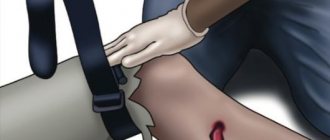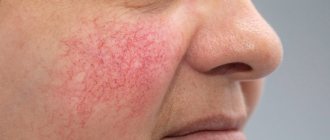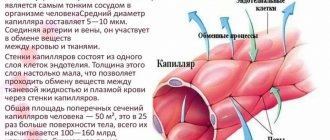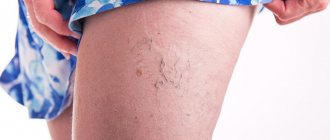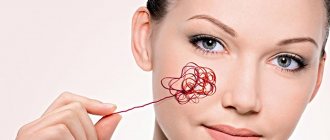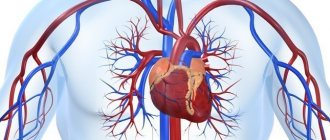Spider veins on the legs, what are they?
Spider veins,
This is what people call varicose capillaries or, scientifically, telangiectasis. The appearance of spider veins and reticular varicose veins on the legs does not always lead to deterioration in health. Some, even leading, specialists in Moscow and the Moscow region attribute them to direct manifestations of varicose veins. And in the modern international classification, spider veins and reticular veins belong to the first class CEAP.
There are several options for the manifestation of spider veins on the lower extremities. These are linear, arachnid, tree-like and point stars.
Several options for spider veins
If patients turn to a good phlebologist at the Moscow City Phlebological Center in the initial stages of the disease, then the problem is more of an aesthetic rather than a medical nature. And there is no point in resorting to serious interventions. Removing spider veins and small reticular veins is quite simple using various innovative sclerotherapy techniques: microsclerotherapy, Foam-form sclerotherapy, microthermocoagulation or ozonosclerotherapy
. Which method will be more preferable will be determined by the phlebologist after examination and modern consultation. In any case, the best result is important to you, and if the doctor knows all the innovative ways to remove stars, then what he prefers for you will most likely not be so important.
Spider veins do not develop clinical symptoms of chronic venous insufficiency (heaviness, fatigue, cramps and swelling). They do not cause complications in the form of thrombosis, thrombophlebitis and trophic ulcers. But they are harbingers of varicose veins and spoil the aesthetic appearance of the legs. Therefore, before removing spider veins, a good ultrasound scan of the great veins is necessary to rule out a more serious medical venous problem. And then, whether you want to remove them or leave them is a purely personal matter.
Most often, when spider veins have just appeared, patients try to remove them with various folk remedies, as well as with the help of ointments, creams and tablets. But seeing the result, or rather the lack thereof, they turn to an aesthetic phlebologist in Moscow.
What complications are possible after treatment for spider veins?
- Superficial necrosis
Removal of telangiectasia can be compared to microsurgery. Phlebologists use special magnifying glasses and illuminators for precise injections into the lumen of spider veins on the skin. Such equipment and the experience of a phlebologist make it possible to make an injection precisely into a microscopic vessel, without introducing sclerosant into the thickness of the skin. If the drug is injected intradermally, punctate necrosis sometimes occurs - small ulcers that do not need to be treated and they heal with small whitish scars.
- Deep necrosis
Another dangerous complication of microsclerotherapy can be injection into an arterial vessel. Entry of sclerosant into such a vessel can cause spasm of the cutaneous arteries and major skin necrosis, which may require long-term treatment and may heal with the formation of a rough scar. This is not the phlebologist’s big fault, but the doctor’s experience in choosing a vessel for injection is very important. Upon detailed examination under magnification, it is possible to distinguish a venous vessel from an arterial one and make the right choice. If the puncture site hurts, or if spots or blisters appear in the injection area, you must immediately inform the phlebologist about this condition.
- Microburns during laser treatment and RFO.
These thermal treatments involve heating and welding the vessels. Due to this, a cosmetic effect is achieved. However, in the hands of an inexperienced specialist, laser coagulation can lead to skin burns due to too long exposure to radiation. Most often, the area of this burn is very small and can clinically appear only as a crust, but sometimes there are deeper skin lesions that form rough scars.
- Meshing and hyperpigmentation after microsclerotherapy.
In approximately 10% of patients treated for intradermal vessels, a very thin venous network, called meting, develops in place of the disappeared asterisk. The occurrence of this problem is impossible to predict and very difficult to combat. Metting more often appears after conventional microsclerotherapy without the use of cold; somewhat less frequently, this problem occurs after laser coagulation and RFO. After the appearance of metting, it is better to stop any attempts to combat the asterisks, since practice shows the impossibility of solving this problem with the help of additional sclerotherapy or laser. Over time, this resulting smoky network may decrease on its own or disappear completely.
Hyperpigmentation is not scary, it will definitely go away, but it can take quite a long time. The appearance of the legs after treatment may not satisfy the patient for six months to two years. To prevent this complication, it is necessary to tell the doctor your contraceptive regimen and receive recommendations for contraception during the course of therapy.
In our clinic, a full course of sclerotherapy on the hips begins a month after the first trial session, at which the rate of disappearance of the venous network and the likelihood of complications are assessed. Depending on the results obtained, a decision is made on the timing of the further course of treatment.
- Early relapse of telangiectasis
No patient is immune from the reappearance of new telangiectasis after microsclerotherapy of the lower extremities. The reasons for the appearance of stars on the skin have not been fully established, but the most recognized theory is the postulate of an imbalance of female sex hormones in the body. The levels of these hormones may be normal, but their ratios are different. This is why it is impossible to predict the duration of the aesthetic effect after microsclerotherapy and laser treatment. Relapses are possible, but if these wreaths disappeared well after the first course of treatment, then they will disappear just as well after subsequent ones. In the hands of an experienced phlebologist, complete success in the aesthetic treatment of telangiectasia is usually achieved.
Causes of spider veins or telangiectasis
Spider veins or telangiectasis appear on the lower extremities due to several reasons. The leading one is long-term static loads on the legs. Simply put, the longer a woman is in an upright position, the greater the load on the vessels. And the asterisks refer to the venous system, which does not have a muscular membrane. Consequently, with a significant increase in the load on the legs, the venous capillaries expand, and this leads to the appearance of unsightly stars.
Other leading medical factors that contribute to the rapid appearance of stars are: pregnancy, especially in the last stages and childbirth (sharp changes in hormonal levels), high heels and uncomfortable shoes, uncontrolled use of hormonal drugs (especially long-term use of contraceptives), excess weight, diseases leading to to hormonal imbalance (uterine fibroids, ovarian cysts, endometriosis), and the most important reason is a hereditary (genetic) predisposition to spider veins (their presence in mothers and grandmothers).
When you can’t remove spider veins with a laser
Laser coagulation has certain contraindications, including:
- diseases of the blood and hematopoietic organs;
- taking medications that thin the blood;
- pregnancy and lactation;
- menstruation;
- diabetes;
- any diseases in the acute stage and other conditions that ILC specialists will definitely tell you about.
Modern methods for removing spider veins
Sclerotherapy is today the best European way to remove spider veins on the legs, and its microfoam form Foam-form sclerotherapy is also absolutely ideal, and also safe. Of course, if it is carried out by a good experienced Moscow aesthetic phlebologist.
Before a microsclerotherapy session for spider veins
Immediately after a microsclerotherapy session for spider veins
Modern sclerotherapy has no absolute contraindications, unlike laser methods for treating spider veins. The microsclerotherapy procedure involves inserting a special adhesive substance, a sclerosant, through a very thin needle into an expanded star, which seals the affected capillary firmly and permanently. After a few weeks, the star completely dissolves, and not a trace remains on the skin. The lifestyle remains virtually unchanged during treatment. The only and main condition for treatment is the need to wear good compression hosiery, which maintains the required level of pressure and prevents the stars from coming apart.
A good modern sclerosant, as it should be
A good modern sclerosant should have the following properties:
- The substance must not be toxic to the human body
- The sclerosing effect should be caused only by a strictly defined concentration of the drug, subject to prolonged contact with the vein wall
- No allergic reactions to sclerosant
- The drug must have the necessary strength to obliterate sufficiently large vessels, and be safe in case of extravasation (going beyond the boundaries of the vessel)
- The drug should not cause scarring or skin pigmentation effects
- No pain effect on drug administration
- The sclerosant must have good solubility in physiological solution.
Prevention of spider veins on the legs in Moscow
To prevent spider veins from appearing, or, if they do appear, to not grow so sharply and increase in size, several important conditions must be met. Avoid uncomfortable shoes, do not wear high-heeled shoes very often, and do not expose your feet to sudden temperature changes or direct sunlight. Get rid of excess weight and do not take hormonal medications without a doctor's prescription. Take daily walks, wear special compression garments when putting stress on your legs, and take a contrast shower before bed.
I hope this simple prevention against spider veins will help you.
So that the blood runs through the veins...
Finally, we would like to offer you some useful tips:
- Don't sit cross-legged;
- When sitting for a long time, for example at a table, place your feet on a small bench;
- When resting at night or during the day, place a pillow under your feet so that your feet and legs are slightly above heart level;
- When traveling by car, it is advisable to stop every 1.5–2 hours, get out of the car, do several squats and walk around for 10–15 minutes;
- If there is a high probability of illness, do not take hot baths, do not visit the bathhouse or sauna;
- Avoid overheating your feet and sunburn;
- Do not wear tight shoes or tight clothing.
How much does it cost to remove spider veins in Moscow
Despite the fact that cosmetologists in many beauty salons perform spider vein removal, they should only be removed in a specialized medical phlebological center. Only the best aesthetic phlebologists will be able to rid you of stars effectively, professionally and without any complications.
| Service | Price |
| Sclerotherapy (microsclerotherapy) on one lower limb (one session) | 8000₽ |
| A course of sclerotherapy after EVLT on one lower limb | 20000₽ |
| Foam (micropoam) sclerotherapy (microsclerotherapy) on one lower limb (one session) | 8000₽ |
| Echo-sclerotherapy under ultrasound guidance on one lower limb (one session) | 10000₽ |
| Postoperative microsclerotherapy on one lower limb (one session) | 4000₽ 8000₽ |
| Sclerotherapy (microsclerotherapy) on one lower limb (course of treatment) | 35000₽ |
| Appointment with phlebologist Semenov A.Yu. with ultrasound scanning based on the results of sclerotherapy | for free |
The price for spider vein removal in Moscow phlebology clinics and beauty salons can vary significantly. It depends on how you remove them. The cost of modern European removal of spider veins in our Moscow phlebology center, where leading aesthetic phlebologist Artem Yuryevich Semenov receives treatment, is 8,000 rubles for a single session.
If a very large amount of work needs to be done, then a course of treatment is possible, which costs 35,000 rubles and does not depend on the number of sessions performed.
Types of modern sclerosants
All modern sclerosants can belong to one of the following groups:
- Detergent preparations. The chemical structure of these substances is based on fatty acids or alcohols. The mechanism of their action is based on the extraction of protein molecules from the surface membrane of the endothelial cell of venous vessels, the cell is irreversibly damaged and dies. This effect works only in the range of a certain sclerosant concentration, below which there is no effect on vascular cells. This group is represented by the following drugs:
- Ethoxysclerol (Polidocanol).
- Sodium tetradecyl sulfate (fiberwein).
Everything is ready for microsclerotherapy
In addition to these drugs, the following detergents are also used in the world: sodium morruate, ethanolamine oleate, glycerin.
- Cell toxin preparations are used by some specialists for sclerosis of vascular formations.
- Hypertonic and ionic solutions. Modern European phlebologists also use the following sclerosants of this group:
- Hypertonic sodium chloride solution (20 and 23.4% solutions).
- Sclerodex (a combination of a solution of 25% glucose and 10% sodium chloride).
- Ionized iodine preparations (variglobin, sclerodin).
- 75% glucose solution.
In Russia today only drugs from the detergent group are approved for use: polidocanol (ethoxysclerol) and tetradecyl sulfate (fiberwein). The issue of admitting 75% glucose solution into medical phlebological practice is being actively resolved.
Reviews about removing spider veins on the legs
I would like to express my deep gratitude to the chief physician and founder of the Center for Modern Phlebology clinic, Artem Yuryevich Semenov!
To the high professionalism of the doctor, add his sensitivity, attentiveness and caring attitude towards the patient, as well as his sense of humor. I had sclerotherapy sessions at his clinic. The doctor removed my so-called spider veins, which so ruin the lives of women! It took me a long time to decide to come. But a friend who already...More details Elena Maksimova, Moscow
I, Tikhomirova Natalya Vasilyevna, express my heartfelt gratitude to the doctor phlebologist Artem Yuryevich Semenov for his skill, professionalism, golden hands, attentiveness and for the miracles that happened to my legs during such a short course of sclerotherapy. Sclerotherapy is an excellent method of treating spider veins that does not take much time, does not cause discomfort, and does not interfere with everyday life. Tikhomirova Natalya Vasilievna, December 23, 2020, Moscow More details
Tikhomirova Natalya Vasilievna, December 23, 2020, Moscow
Microsclerotherapy techniques used in the Moscow City
At the Moscow City Phlebology Center we use only the most modern types of microsclerotherapy (scleroobliteration of veins).
Sclerosants for microsclerotherapy
- Telangiectasia (spider veins), diameter up to 1 mm, are removed using a liquid form of the drug: polidocanol (0.25 - 0.75%), tetradecyl sulfate (0.1 - 0.2%).
- To remove venulectasias (diameter 1-2 mm) and reticular veins (2-4 mm), both microsclerotherapy solution and microfoam sclerotherapy (foam-form) are used. Concentration of active substance: polidocanol - 0.5-1%, sodium tetradecyl sulfate - 0.25-0.4%.
How and why do varicose veins develop?
Blood flows through the veins in only one direction - up to the right side of the heart. Valves on the walls of blood vessels prevent its reverse movement. If they fail, the blood stagnates, stretches and deforms the veins.
Risk factors include:
- pregnancy;
- physical inactivity;
- constant static loads;
- obesity;
- lifting weights;
- dyshormonal conditions;
- frequent constipation, lack of fiber in the diet;
- high heels.
Varicose veins are a disease with a genetic predisposition. The failure of the vessel wall and valve apparatus is inherited. The pathological process develops under the influence of provoking factors.
Why is it better to contact the Central Clinical Hospital of the Russian Academy of Sciences?
- Doctors of the highest category, doctors and candidates of medical sciences work with patients.
- The clinic has extensive diagnostic capabilities: a multifunctional laboratory, expert-level equipment, doctors of almost all medical specializations.
- The effectiveness of treatment of vascular pathology in the clinic corresponds to the experience of the world's best clinics, but the cost is significantly lower.
- There are only positive reviews from patients and colleagues about our work.
If you are looking for where to undergo sclerotherapy of the veins of the lower extremities in Moscow, contact the Central Clinical Hospital of the Russian Academy of Sciences. The final price for the procedures can be found out during a consultation with a doctor. Make an appointment by applying on our website.
